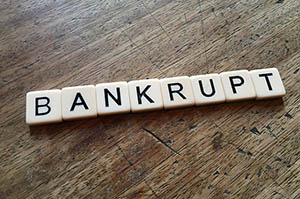The state of bankruptcy of an insurance company
An insurer becomes bankrupt when its situation is no longer viable or is unlikely to be viable, and there is no reasonable prospect of recovering the situation through the company's own resources.
The liquidation process is generally initiated after the insurer has been declared insolvent. Insolvency may play out at the level of:
- the balance sheet, which shows liabilities exceeding assets,
- the cash flows when the insurer becomes unable to pay its debts as they fall due.
 The insurer's failure is thus triggered by its "non-viability." The failing insurer ceases to operate in its usual form. The shareholders lose all or part of their equity (capital + accumulated dividends) and can no longer challenge the measures decided by the regulatory authority, which is responsible for supervising the sector and liquidating the company.
The insurer's failure is thus triggered by its "non-viability." The failing insurer ceases to operate in its usual form. The shareholders lose all or part of their equity (capital + accumulated dividends) and can no longer challenge the measures decided by the regulatory authority, which is responsible for supervising the sector and liquidating the company.
Définition de faillite d’une compagnie d’assurance
Bankruptcy can be defined as the inability of a company to meet its commitments. When a company stops paying, it becomes insolvent.
For an insurance company, bankruptcy has an impact on:
- policyholders who are partially compensated or not compensated at all for claims. In addition to the non-payment of claims, policyholders lose some or the entirety of their unpaid premiums.
- the entire market which could be required to bear:
- an increase in taxes, stiffer regulations, the establishment of a solidarity fund, …
- an increase in insurance premiums to make up for the deficit,
- the transfer of the liabilities of the defaulting company to other insurance companies,
- a decrease of competition on the market, triggering a pressure on premiums,
- a loss of image and confidence with the general public.
- other insurance companies in the market with which it has co-insurance or reinsurance ties. In such a case, the entire payment of premiums and claims is compromised.
Read also | Bankrupt insurance companies: 1992-2022
Insurance company bankruptcy: the portfolio sale
A company in financial difficulty may seek a solution to its financial problems in order to avoid the worsening of its situation and the withdrawal of its license.
In such a case, the insurer sells its portfolio to a competitor, that could then either buy the assets and liabilities or only the current portfolio.
In most countries, the insurance code provides for several articles to the management of companies in difficulty. The legislation often provides for the establishment of specialized funds or pools responsible for compensating policyholders in the event that an insurance company ceases operations.
Read also | List of the main guarantee funds by country
The causes of bankruptcy of insurance companies
The bankruptcy of an insurance company results from a chain of multiple causes, associated with poor management, with decision-making becoming inadequate, underestimating or ignoring risks. This vulnerability to "triggering events" leads in turn to unfavorable financial results and sometimes losses to policyholders.
The risks faced by insurers can be classified according to their causes or effects. The 2016 Eiopa (European Insurance and Occupational Pensions Authority) resistance survey outlines the main vulnerabilities of the European insurance sector that could lead to insolvency.
Risks associated with management and staff competence and with governance and internal control are the top two causes of vulnerability for an insurance company. Underwriting risk, which is a technical risk by nature, comes in third place.
The two main risks to which an insurance company is exposed are related to its governance and to the competence of its management and staff. These have a direct influence on the underlying risks of a purely technical nature: underwriting risk, insufficient technical reserves, accounting risk, etc.
It is worth noting that the classification and importance of bankruptcy causes differ from region to region and from country to country. For example, in Europe and for the Eiopa study, the risk of fraud is not one of the main causes of failure of an insurance company, just like social, political, legal and fiscal risks.
The effects of an insurance company bankruptcy
According to insurance principles, when a company is bankrupt, the contracts it holds in its portfolio automatically cease to have effect starting from a certain number of days (40 days in the CIMA zone countries) from the date of publication in a legal gazette of the decision to withdraw the license.
Premiums are due in proportion to the period of coverage, while the liquidator may defer claim settlements.
Insurance company bankruptcy: license withdrawal
When a company is in a difficult financial situation and is unable to meet its obligations, the supervisory authorities may intervene and impose a recovery plan designed to bring the company back up to standard.
If, after a certain period of time, it is established that the company cannot be rehabilitated, the authorities may then initiate a liquidation operation, that is, proceed to the withdrawal of license.
Declared insolvent, the company is then managed by a court-appointed liquidator. The latter must deal with the various creditors of the failing insurer. The liquidator's primary mission is to preserve the interests of the policyholders and beneficiaries of indemnities (outstanding claims, payment of annuities and pensions).